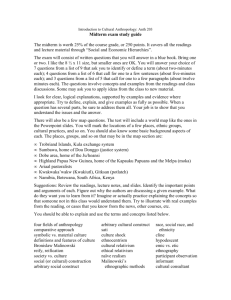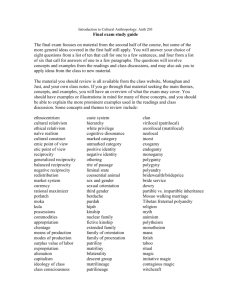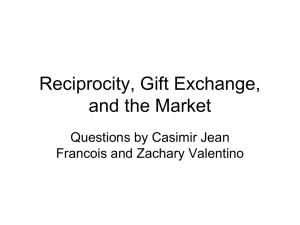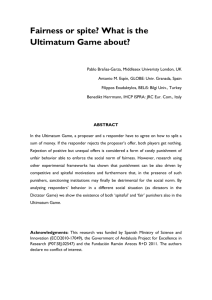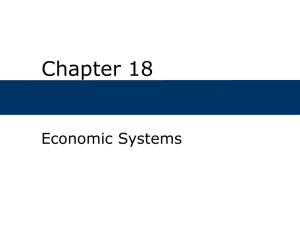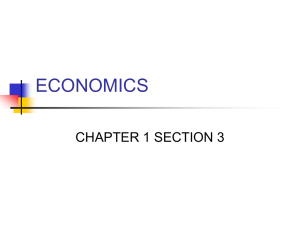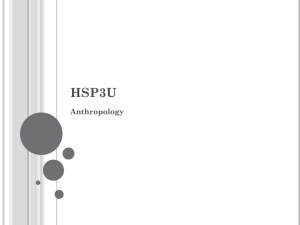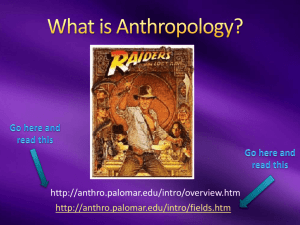Chapter 8 Economics - MDC Faculty Home Pages
advertisement
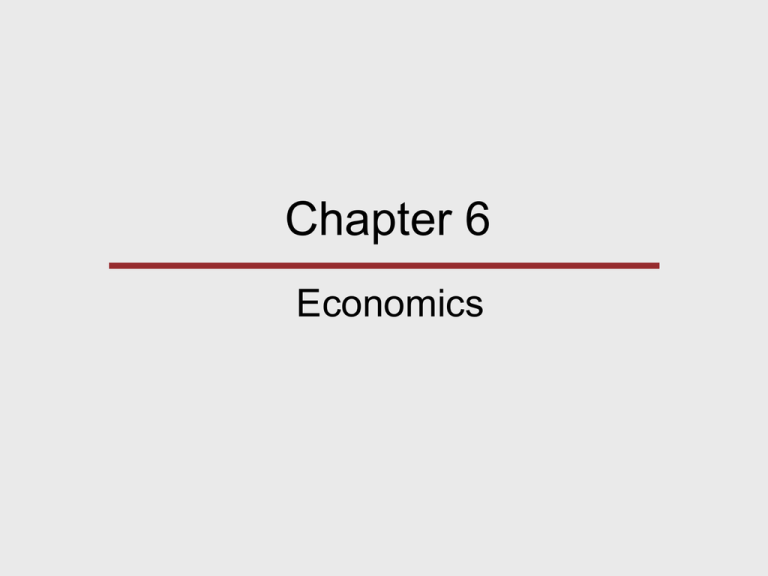
Chapter 6 Economics Chapter Outline • • • • • • Ultimate Dictator Economic Behavior Allocating Resources Organizing Labor Distribution: Systems of Exchange and Consumption Bringing it Back Home: Product Anthropology Ultimate Dictator • • The notion that human beings are “economic men” underlies much of Western economic theory. The idea that people are capable of assessing their economic choices and making decisions that maximize their wealth and minimize their labor Ultimate Dictator • • Economists and anthropologists developed tools to test the degree to which people in different cultures behave like the “economic man” of the theory. Examples: • Dictator game • Ultimatum game Dictator Game • • • Two individuals: “proposer” and “responder.” The proposer is given a sum of money and told to split it with the responder. If people try to maximize their wealth and minimize their work, we would expect the proposer to keep the entire sum. Dictator Game • • In the United States and other wealthy nations, 30 to 40% of the players take the whole pot. Most proposers leave between 20 and 30% for the responders. Ultimatum Game • • In this game, the proposer offers to split a sum of money and the responder may either accept or reject the split. If the responder accepts the split, the money is divided and the game is over. Ultimatum Game • • If the responder rejects the split, neither player receives any money and the game ends. A respondent who behaved like “economic man” would accept the offer since accepting the offer involves no financial cost and even a very low offer is greater than nothing. Ultimatum Game • • Anthropologists and economists have played the ultimatum game with members of many different cultures. The results showed large variations. • Among the Machiguenga of the Peruvian Amazon, proposers rarely offered more than 15% and offers were almost never rejected. • American college students offered 42-48% and responders tended to reject offers of less than 30%. Ultimate Dictator • • • The results of the dictator and ultimatum games demonstrate the social and cultural dimensions of economic decision making. The fact that a strong majority of proposers give responders something may show that all people have a bias toward generosity. The differences among cultures demonstrate that decisions are set in cultural contexts that determine behavior and these are different in different economic systems. Economics • The study of how the choices people make determine how their society uses resources to produce and distribute goods and services Economic System • • • The part of society that deals with production, distribution, and consumption of goods and services The way production is organized has consequences for the family and the political system. Economics is embedded in the social process and cultural pattern. Economic Behavior • Choosing a course of action that pursues the course of perceived maximum benefit Allocating Resources • • Each society has rules to regulate access to resources. Productive resources are used to create other goods or information. • Land, water, tools, and knowledge are productive resources. Productive Resources: Foragers • • • • Foraging requires people to spread out over a large area. Boundaries can be adjusted as the availability of resources change. Where resources are scarce and large areas are needed to support the population, boundaries are not usually defended. Where resources are abundant, groups may be more inclined to defend their territory. Productive Resources: Pastoralists • • The most critical resources are livestock and land. Livestock are owned and managed by individuals, land and water are generally not owned. Productive Resources: Pastoralists • • • In the rainy season, cattle graze in areas unsuitable for farming. In the dry season, they move to areas occupied by farmers. Agreements with landowners allow animals to graze on the stubble from harvested fields. Productive Resources: Horticulturists • • • In horticulture societies, land is communally owned by an extended kin group. Designated officials allocate rights to use land, which may not be sold. Since almost everyone belongs to a landcontrolling kin group, few are deprived of access to this basic resource. Productive Resources: Horticulturists • • • Often involves investing labor in clearing, cultivating, and maintaining land The rights to cleared land and its products are vested in those who work it. Individuals may die while the land is still productive, so a system of inheritance is usually provided. Productive Resources: Agriculturists • • • • Enormous amounts of labor are invested in the land and large quantities of food are produced. Control of the land becomes an important source of wealth and power. Land ownership moves from the kin group to the individual or family. The owner has the right to keep others off the land and dispose of it as he or she wishes. Productive Resources: Intensive Cultivation • • • Land and other productive resources are likely to be owned by an elite group. Most fieldwork is done by laborers, often referred to as peasants. Landowners enjoy relatively high standards of living, but peasants do not. Organizing Labor • • In small-scale preindustrial and peasant economies, the household or some extended kin group is the basic unit of production and consumption. Labor is just one aspect of membership in a social group such as the family. Organizing Labor • • In Western society, work has important social implications. For many people, particularly members of the middle classes, work is a source of self-respect, challenge, growth, and personal fulfillment. Households • • In most nonindustrial societies, production is based around the household. The household is an economic unit, people united by kinship or other links who share a residence and organize production, consumption, and distribution among themselves. Gendered Division of Labor • • • In all human societies, some tasks are considered appropriate for women and others appropriate for men. At some level, the sexual division of labor is biological since only women can bear and nurse children. Caring for infants is almost always a female role and usually central to female identity. Specialization in Complex Societies • • • The division of labor becomes more specialized as the population increases and agricultural production intensifies. Occupational specialization spreads as individuals are able to exchange services or products for food and wealth. Specialists are likely to include soldiers, government officials, and members of the priesthood as well as artisans, craftsmen and merchants. Specialized Labor How does this work in a sneaker factory in Mexico differ from that of a forager? Patterns of Exchange • • • Reciprocity Redistribution Market Types of Reciprocity • • • Generalized – Distribution of goods with no specific return expected Balanced – Exchange of goods of equal value, with an obligation to return them. Negative – Exchange conducted for material advantage Generalized Reciprocity • • • Generalized reciprocity involving food is an important social mechanism among foraging peoples. Hunters distribute meat among members of the kin group or camp. Each person or family gets an equal share or a share dependent on its kinship relationship to the hunter. Generalized Reciprocity • • Hunters gain satisfaction from accomplishing a highly skilled and difficult task. Because all people in the society are bound by the same rules, the system gives them all opportunity to give and receive. Balanced Reciprocity • • Involves greater social distance and includes the obligation to return, within a reasonable time limit, goods of nearly equal value to those given Characteristic of trading relations among non-industrialized peoples without market economies Kula Ring • • Pattern of exchange among trading partners in the Trobriands and other South Pacific islands The kula trade moves two types of prestige goods from island to island around the Kula circle. • Soulava, necklaces of red shell, move in a clockwise direction. • Mwali, bracelets of white shell, move counterclockwise. Kula Ring • Although Kula items can be owned and may be taken out of circulation, people generally hold them for a while and then pass them on. Kula Ring Kula trading partnerships are lifelong affairs, and their details are fixed by tradition. Redistribution • Exchange in which goods are collected from members of the group and then redistributed to the group Leveling Mechanism • • A practice, value, or form of social organization that evens out wealth in a society If generosity rather than the accumulation of wealth is the basis for prestige, those who desire prestige will distribute much of their wealth. Potlatch • A form of redistribution involving competitive feasting practiced among Northwest Coast Native Americans Cargo System • A ritual system common in Central and South America in which wealthy people are required to hold a series of costly ceremonial offices Market Exchange • • • Economic system in which goods and services are bought and sold at a price determined by supply and demand Impersonal and occurs without regard to the social position of the participants When this is the key economic institution, social and political goals are less important than financial goals. Capitalism • • Economic system in which: • people work for wages. • land and goods are privately owned. • capital is invested for individual profit. A small part of the population owns most of the resources or capital goods. Bringing it Back Home: Product Anthropology • • New product ethnography is a way of turning the techniques and theories of anthropology into a resource for the corporate world. Those who promote it argue that anthropologists should provide information that helps corporations design and market products. Bringing it Back Home: Product Anthropology • • • The involvement of anthropologists in these fields raises ethical problems. If corporations profit from information that anthropologists received from informants, is payment owed to the informants? Should anthropology be a way to help corporations make more money? Bringing it Back Home: Product Anthropology • You decide: • Historically the introduction of cheap, mass produced goods has undercut existing economies and drawn people in as consumers of low quality merchandise and low paid wage earners. • Given this, should anthropologists be involved in the design and marketing of products to groups about which they have expertise? Bringing it Back Home: Product Anthropology • You decide: • With the aid of anthropologists, corporations can produce products that meet local needs and are marketed in culturally appropriate ways. • The alternative is often inappropriate, poorly designed, and poorly marketed products. • Given this, can anthropologists justifiably refuse to work with corporations? Quick Quiz 1. When you pay your taxes to the U. S. Government, you are part of a system of a) negative reciprocity. b) redistribution. c) balanced reciprocity. d) generalized reciprocity. e) exchange similar to the Kula Ring. Answer: b • When you pay your taxes to the U. S. Government, you are part of a system of redistribution. 2. A tradition of hosting redistributive community feasts or distributing gifts as a way of gaining prestige and often power by those who have more wealth than others is known as a) balanced reciprocity. b) a leveling mechanism. c) penny capitalism. d) charity. Answer: b • A tradition of hosting redistributive community feasts or distributing gifts as a way of gaining prestige and often power by those who have more wealth than others is known as a leveling mechanism. 3. A farmer's access to or ownership of land, water, and knowledge necessary for successful farming are referred to in economics as: a) goods and services. b) a negative resource base. c) raw materials. d) investments. e) productive resources. Answer: e • A farmer's access to or ownership of land, water, and knowledge necessary for successful farming are referred to in economics as productive resources.
